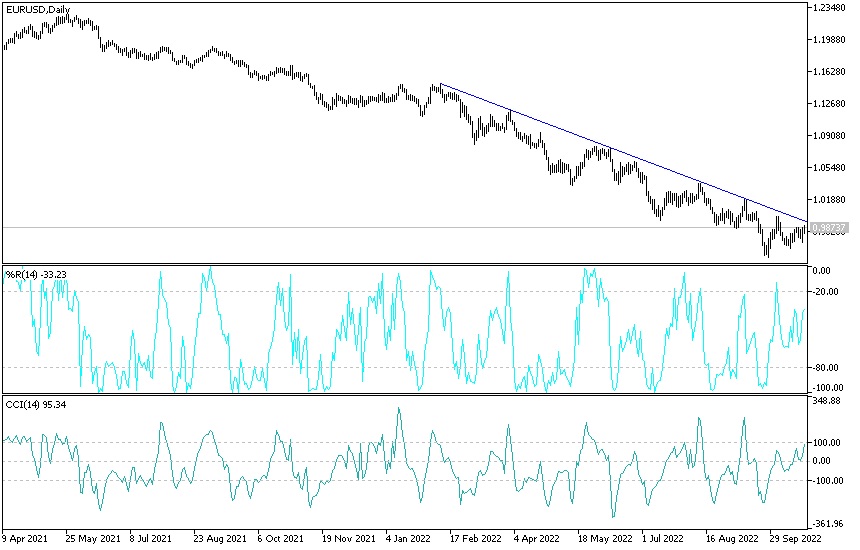[ad_1]
The results of the rapid survey from S&P Global on Monday showed that private activity in the euro zone slipped into a deep slowdown in October as the manufacturing and services sectors contracted at faster rates.
- With the start of this week’s trading, the price of the EUR/USD currency pair succeeded in maintaining the gains of the end of last week.
- It was trying to break the resistance at 0.9900, but it did not find the momentum to do so, and it settled around the 0.9880 level at the time of writing the analysis.
- Much of this week’s performance will likely depend on the market’s response to Thursday’s interest rate decision from the European Central Bank, which is widely expected to raise the benchmark interest rate by three-quarters of a percentage point for the second time in a row.
This will narrow the already low historical gap between US and Eurozone interest rates, which is expected to affect the EURUSD, although the ECB’s hawkish shift and various interest rate hikes have not led to much of an advantage. The currency so far is weak. Commenting on the event, Carol Kong, a currency analyst at the Commonwealth Bank of Australia, said: “We expect the European Central Bank to introduce a second consecutive increase in interest rates by 75 basis points on Thursday. We also expect his post-meeting comment to be hawkish as inflation is high and inflation expectations are on the rise.”
“Markets are pricing in a 75 basis point rise in November and December. As a result, we don’t see a high probability of a hawkish surprise that will support the euro,” she added.
The results of the rapid survey from S&P Global on Monday showed that private activity in the euro zone slipped into a deep slowdown in October as the manufacturing and services sectors contracted at faster rates. According to the advertiser, the S&P Global Composite Production Index fell to a 23-month low of 47.1 in October from 48.1 the previous month. The reading was also below economists’ expectations of 47.5. The index remained below the 50.0 level for the fourth consecutive month, indicating deflation. The recent pace of decline was the fastest since November 2020.
Excluding the months of epidemic lockdown, the October score was the lowest since April 2013.
The contraction in the private sector was mainly driven by industrial activity. Manufacturing production fell for the fifth consecutive month and has not seen the last pace of decline before the pandemic since July 2012. The manufacturing PMI fell more-than-expected to 46.6 from 48.4 in September. The reading was expected to rise to 47.8. Meanwhile, the cost of living crisis and widespread economic uncertainty have dampened service activity. The Services PMI came in at a 20-month low of 48.2, as expected, but down from 48.8 a month ago.
Commenting on the results, Chris Williamson, chief business economist at S&P Global Market Intelligence, said the euro zone economy appears to be on the cusp of contraction in the fourth quarter due to severe production losses and a worsening demand picture seen in October. This adds to speculation that a recession appears inevitable.
The survey showed that new orders for goods and services fell for the fourth consecutive month. The drop in new orders has caused companies to continue to rely on existing backlogs to help maintain levels of business activity. The overall rate of input cost inflation remained very high, declining only slightly from a three-month high in September. Higher costs led to higher rates of price hikes for goods and services. Sales price inflation cooled only slightly in both manufacturing and services.
Within the eurozone, the biggest drop continued to be recorded in Germany, with the composite PMI falling to 44.1, its lowest level since May 2020, from 45.7 in September. The expected result was 45.3.
EUR/USD Forecast
According to the performance on the daily chart below, and despite the attempts to rebound upwards, the price of the currency pair EUR/USD is still in a neutral position and the stronger tendency is to the downside as long as it is stable below the parity price. The aftermath of the Russian-Ukrainian war negatively affects the sentiment of investors towards the euro. The break of the 0.9750 support is important for more bears’ control, and the bulls will not have a chance to take control without settling above the parity price. I expect the euro-dollar price to try to maintain some of its gains until the markets react to the announcement of the monetary policy decisions of the European Central Bank this week.

Ready to trade our Forex prediction today? We’ve shortlisted the best Forex trading brokers in the industry for you.
[ad_2]
Source link







